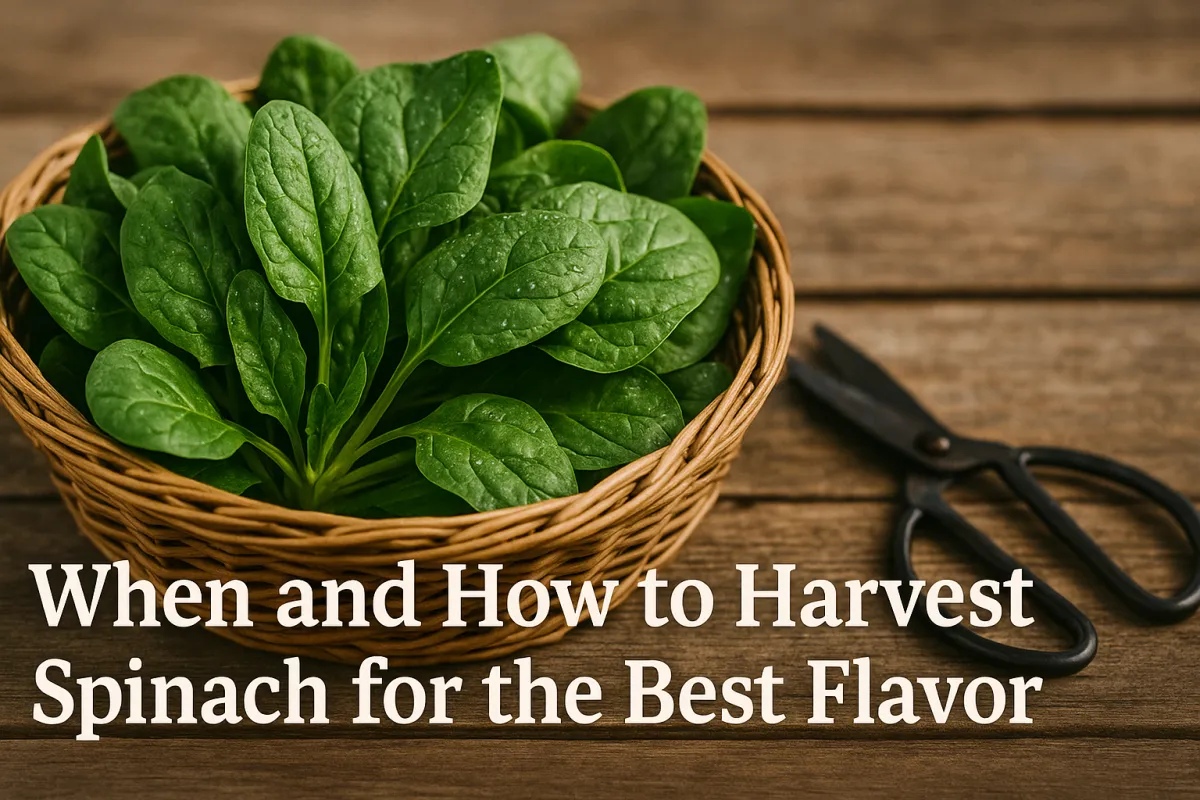
When and How to Harvest Spinach for the Best Flavor
When and How to Harvest Spinach for the Best Flavor
The Day I Learned Spinach Has a Deadline
I remember the first year I grew spinach on my own. The plants were lush and green, and I told myself I’d wait “just one more day” to get a little more size out of the leaves. That one more day turned into three, and by the time I finally cut them, the flavor had turned sharp and bitter.
That’s the thing about spinach: it waits for no one. The difference between sweet, tender leaves and tough, bitter ones can be a matter of just a couple of days. Harvesting at the right time — and the right way — is the key to enjoying the best flavor your garden can offer.
Baby Leaf vs. Mature Leaf Harvest Windows
Spinach gives you options. You can pick it early for delicate baby leaves or let it grow to full maturity for larger, bolder greens.
Baby leaf spinach: Leaves 2–4 inches long, mild and tender. Perfect for salads. Usually ready 25–35 days after planting.
Mature spinach: Leaves 5–8 inches long, with more texture and deeper flavor. Usually ready 40–50 days after planting.
USDA Zone timing:
In cooler climates (Zones 3–6), you have a wider harvest window because plants grow more slowly in the cool air.
In warmer zones (Zones 7–10), spinach grows fast — sometimes too fast — so keep a close eye on size and color.
Flavor tip: Baby leaves are sweeter, but mature leaves are better for cooking. Choose based on how you plan to use them.
Step-by-Step Harvest Guide to Keep the Leaves Coming
Harvest in the morning when leaves are crisp and full of moisture.
Pick from the outside in — the oldest leaves grow on the outer edge; leave the center crown untouched so new leaves can grow.
Cut, don’t pull. Use clean scissors or garden shears and snip stems about ½ inch above the crown.
Take no more than one-third of the plant at a time to avoid stressing it.
Water after harvesting to help plants bounce back quickly.
With this “cut-and-come-again” method, you can keep the same spinach bed producing for weeks.
Grandma’s Tip
“If it looks ready today, it was ready yesterday.”
Grandma never waited on spinach. She knew the sweetness doesn’t last long — and neither should your hesitation.
How to Store Spinach for Maximum Freshness
Once spinach leaves are cut, the clock starts ticking. Handle them right, and you can get a full week of good eating.
Dry storage: Place unwashed leaves between paper towels in a container or resealable bag. Store in the crisper drawer.
Moisture control: Too much water speeds decay. Keep leaves just barely damp, not wet.
Wash before eating — unless your soil is sandy, wait to rinse until just before use.
Freezing option: Baby leaves freeze well for smoothies; blanch mature leaves first for cooking use later.
Signs You’ve Missed the Perfect Window
If you see these, the best flavor has already passed:
Thick, fibrous stems.
Dark, tough leaves.
Leaves curling or yellowing at the edges.
A central stalk shooting upward — a sign the plant is bolting to seed.
Once bolting starts, bitterness comes fast.
Temperature and Its Impact on Spinach Quality
Spinach is a cool-season crop, happiest between 45–65°F.
Cool weather slows growth, giving you more time to harvest.
Warm weather speeds maturity and triggers bolting, sometimes in just days.
Prevention tips:
Use shade cloth when daytime temps climb above 75°F.
Plant successions every 2–3 weeks in spring and fall.
In hot climates, grow spinach through winter for the best flavor.
Pro Tips — Mistakes to Avoid
Waiting for every leaf to “size up” — harvest regularly for sweeter leaves.
Picking in midday heat — wilted leaves lose quality fast.
Storing leaves wet — moisture accelerates spoilage.
Region-Specific Notes
Zones 3–6: Best harvests in spring and fall. Winter harvest possible with protection.
Zones 7–10: Grow from late fall through early spring; harvest before heat sets in.
Microclimates matter — shaded beds can buy you a few more days in warm spells.
Lead Magnet — Spinach Harvest Cheat Sheet
Download my printable Spinach Harvest Cheat Sheet for quick-reference harvest times, cutting methods, and storage tips.
(Perfect to hang in the garden shed or keep inside your seed binder.)
Harvest While the Blessing Is Fresh
The Bible says, “To everything there is a season, a time for every purpose under heaven” (Ecclesiastes 3:1). Spinach has its season, and it’s short.
Don’t wait for perfect — pick when it’s good, and enjoy it while the sweetness lasts. If you’ve got a bed ready now, take a basket out there tonight and harvest what’s waiting. Tomorrow might be too late.


Facebook
Instagram
X
Youtube